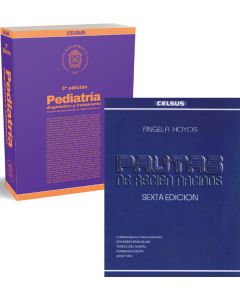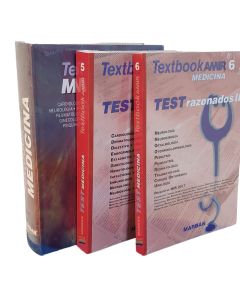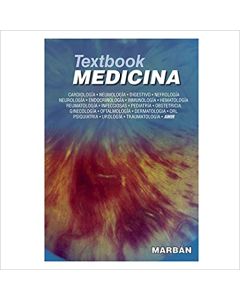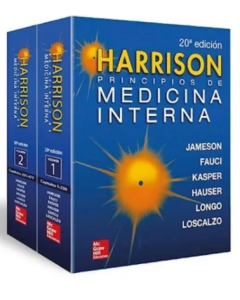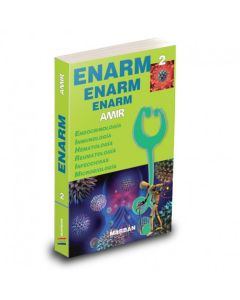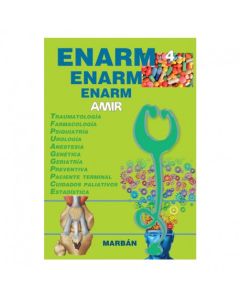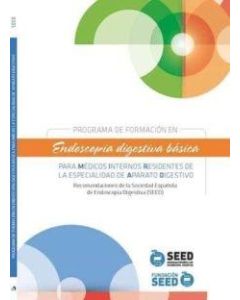En oferta
Textbook Of Medical Physiology 13Ed Ise
Incluye Gastos de Importación
-
Especialidad
- Fisiología

- Precio Lista USD $ 90.000
- Precio CELSUS USD $ 60.000 En oferta
- Cover image
- Title page
- Table of Contents
- Copyright
- Dedication
- Preface
- Unit I Introduction to Physiology: The Cell and General Physiology
- Chapter 1 Functional Organization of the Human Body and Control of the “Internal Environment”
- Cells are the Living Units of the Body
- Extracellular Fluid—the “Internal Environment”
- Homeostasis—Maintenance of A Nearly Constant Internal Environment
- Control Systems of the Body
- Summary—Automaticity of the Body
- Bibliography
- Chapter 2 The Cell and Its Functions
- Organization of the Cell
- Physical Structure of the Cell
- Comparison of the Animal Cell with Precellular Forms of Life
- Functional Systems of the Cell
- Locomotion of Cells
- Bibliography
- Chapter 3 Genetic Control of Protein Synthesis, Cell Function, and Cell Reproduction
- Genes in the Cell Nucleus Control Protein Synthesis
- The DNA Code in the Cell Nucleus is Transferred to RNA Code in the Cell Cytoplasm—The Process of Transcription
- Synthesis of Other Substances in the Cell
- Control of Gene Function and Biochemical Activity in Cells
- The DNA–Genetic System Controls Cell Reproduction
- Cell Differentiation
- Apoptosis—Programmed Cell Death
- Cancer
- Bibliography
- Unit II Membrane Physiology, Nerve, and Muscle
- Chapter 4 Transport of Substances Through Cell Membranes
- The Cell Membrane Consists of a Lipid Bilayer with Cell Membrane Transport Proteins
- Diffusion
- “Active Transport” of Substances Through Membranes
- Bibliography
- Chapter 5 Membrane Potentials and Action Potentials
- Basic Physics of Membrane Potentials
- Measuring the Membrane Potential
- Resting Membrane Potential of Neurons
- Neuron Action Potential
- Propagation of the Action Potential
- Re-Establishing Sodium and Potassium Ionic Gradients After Action Potentials are Completed—Importance of Energy Metabolism
- Plateau in Some Action Potentials
- Rhythmicity of Some Excitable Tissues—Repetitive Discharge
- Special Characteristics of Signal Transmission in Nerve Trunks
- Bibliography
- Chapter 6 Contraction of Skeletal Muscle
- Physiological Anatomy of Skeletal Muscle
- General Mechanism of Muscle Contraction
- Molecular Mechanism of Muscle Contraction
- Energetics of Muscle Contraction
- Characteristics of Whole Muscle Contraction
- Bibliography
- Chapter 7 Excitation of Skeletal Muscle: Neuromuscular Transmission and Excitation-Contraction Coupling
- Transmission of Impulses from Nerve Endings to Skeletal Muscle Fibers: the Neuromuscular Junction
- Muscle Action Potential
- Excitation-Contraction Coupling
- Bibliography
- Chapter 8 Excitation and Contraction of Smooth Muscle
- Contraction of Smooth Muscle
- Regulation of Contraction by Calcium Ions
- Nervous and Hormonal Control of Smooth Muscle Contraction
- Bibliography
- Unit III The Heart
- Chapter 9 Cardiac Muscle; The Heart as a Pump and Function of the Heart Valves
- Physiology of Cardiac Muscle
- Cardiac Cycle
- Regulation of Heart Pumping
- Bibliography
- Chapter 10 Rhythmical Excitation of the Heart
- Specialized Excitatory and Conductive System of the Heart
- Control of Excitation and Conduction in the Heart
- Bibliography
- Chapter 11 The Normal Electrocardiogram
- Characteristics of the Normal Electrocardiogram
- Flow of Current Around the Heart During the Cardiac Cycle
- Electrocardiographic Leads
- Methods for Recording Electrocardiograms
- Bibliography
- Chapter 12 Electrocardiographic Interpretation of Cardiac Muscle and Coronary Blood Flow Abnormalities: Vectorial Analysis
- Principles of Vectorial Analysis of Electrocardiograms
- Vectorial Analysis of the Normal Electrocardiogram
- Mean Electrical Axis of the Ventricular QRS and Its Significance
- Conditions that Cause Abnormal Voltages of the QRS Complex
- Prolonged and Bizarre Patterns of the QRS Complex
- Current of Injury
- Abnormalities in the T Wave
- Bibliography
- Chapter 13 Cardiac Arrhythmias and Their Electrocardiographic Interpretation
- Abnormal Sinus Rhythms
- Abnormal Rhythms that Result from Block of Heart Signals within the Intracardiac Conduction Pathways
- Premature Contractions
- Paroxysmal Tachycardia
- Ventricular Fibrillation
- Atrial Fibrillation
- Atrial Flutter
- Cardiac Arrest
- Bibliography
- Unit IV The Circulation
- Chapter 14 Overview of the Circulation; Biophysics of Pressure, Flow, and Resistance
- Physical Characteristics of the Circulation
- Basic Principles of Circulatory Function
- Interrelationships of Pressure, Flow, and Resistance
- Bibliography
- Chapter 15 Vascular Distensibility and Functions of the Arterial and Venous Systems
- Vascular Distensibility
- Arterial Pressure Pulsations
- Veins and Their Functions
- Bibliography
- Chapter 16 The Microcirculation and Lymphatic System: Capillary Fluid Exchange, Interstitial Fluid, and Lymph Flow
- Structure of the Microcirculation and Capillary System
- Flow of Blood in the Capillaries—Vasomotion
- Exchange of Water, Nutrients, and Other Substances between the Blood and Interstitial Fluid
- Interstitium and Interstitial Fluid
- Fluid Filtration Across Capillaries is Determined by Hydrostatic and Colloid Osmotic Pressures and the Capillary Filtration Coefficient
- Lymphatic System
- Bibliography
- Chapter 17 Local and Humoral Control of Tissue Blood Flow
- Local Control of Blood Flow in Response to Tissue Needs
- Mechanisms of Blood Flow Control
- Humoral Control of the Circulation
- Bibliography
- Chapter 18 Nervous Regulation of the Circulation and Rapid Control of Arterial Pressure
- Nervous Regulation of the Circulation
- Special Features of Nervous Control of Arterial Pressure
- Bibliography
- Chapter 19 Role of the Kidneys in Long-Term Control of Arterial Pressure and in Hypertension: The Integrated System for Arterial Pressure Regulation
- Renal–Body Fluid System for Arterial Pressure Control
- The Renin-Angiotensin System: Its Role in Arterial Pressure Control
- Summary of the Integrated, Multifaceted System for Arterial Pressure Regulation
- Bibliography
- Chapter 20 Cardiac Output, Venous Return, and Their Regulation
- Normal Values for Cardiac Output at Rest and During Activity
- Control of Cardiac Output by Venous Return—The Frank-Starling Mechanism of the Heart
- Pathologically High or Low Cardiac Outputs
- Methods for Measuring Cardiac Output
- Bibliography
- Chapter 21 Muscle Blood Flow and Cardiac Output During Exercise; the Coronary Circulation and Ischemic Heart Disease
- Blood Flow Regulation in Skeletal Muscle at Rest and During Exercise
- Coronary Circulation
- Bibliography
- Chapter 22 Cardiac Failure
- Circulatory Dynamics in Cardiac Failure
- Unilateral Left Heart Failure
- Low-Output Cardiac Failure—Cardiogenic Shock
- Edema in Patients with Cardiac Failure
- Cardiac Reserve
- Bibliography
- Chapter 23 Heart Valves and Heart Sounds; Valvular and Congenital Heart Defects
- Heart Sounds
- Abnormal Circulatory Dynamics in Valvular Heart Disease
- Abnormal Circulatory Dynamics in Congenital Heart Defects
- Use of Extracorporeal Circulation during Cardiac Surgery
- Hypertrophy of the Heart in Valvular and Congenital Heart Disease
- Bibliography
- Chapter 24 Circulatory Shock and Its Treatment
- Physiological Causes of Shock
- Shock Caused by Hypovolemia—Hemorrhagic Shock
- Neurogenic Shock—Increased Vascular Capacity
- Anaphylactic Shock and Histamine Shock
- Septic Shock
- Physiology of Treatment in Shock
- Circulatory Arrest
- Bibliography
- Unit V The Body Fluids and Kidneys
- Chapter 25 The Body Fluid Compartments: Extracellular and Intracellular Fluids; Edema
- Fluid Intake and Output are Balanced during Steady-State Conditions
- Body Fluid Compartments
- Constituents of Extracellular and Intracellular Fluids
- Measurement of Fluid Volumes in the Different Body Fluid Compartments—the Indicator-Dilution Principle
- Determination of Volumes of Specific Body Fluid Compartments
- Regulation of Fluid Exchange and Osmotic Equilibrium between Intracellular and Extracellular Fluid
- Volume and Osmolality of Extracellular and Intracellular Fluids in Abnormal States
- Glucose and Other Solutions Administered for Nutritive Purposes
- Clinical Abnormalities of Fluid Volume Regulation: Hyponatremia and Hypernatremia
- Edema: Excess Fluid in the Tissues
- Fluids in the “Potential Spaces” of the Body
- Bibliography
- Chapter 26 The Urinary System: Functional Anatomy and Urine Formation by the Kidneys
- Multiple Functions of the Kidneys
- Physiological Anatomy of the Kidneys
- Micturition
- Urine Formation Results From Glomerular Filtration, Tubular Reabsorption, and Tubular Secretion
- Bibliography
- Chapter 27 Glomerular Filtration, Renal Blood Flow, and Their Control
- Glomerular Filtration—the First Step in Urine Formation
- Determinants of the GFR
- Renal Blood Flow
- Physiological Control of Glomerular Filtration and Renal Blood Flow
- Autoregulation of GFR and Renal Blood Flow
- Bibliography
- Chapter 28 Renal Tubular Reabsorption and Secretion
- Tubular Reabsorption is Quantitatively Large and Highly Selective
- Tubular Reabsorption Includes Passive and Active Mechanisms
- Reabsorption and Secretion Along Different Parts of the Nephron
- Regulation of Tubular Reabsorption
- Use of Clearance Methods to Quantify Kidney Function
- Bibliography
- Chapter 29 Urine Concentration and Dilution; Regulation of Extracellular Fluid Osmolarity and Sodium Concentration
- Kidneys Excrete Excess Water by Forming Dilute Urine
- Kidneys Conserve Water by Excreting Concentrated Urine
- Special Characteristics of the Loop of Henle That Cause Solutes to be Trapped in the Renal Medulla
- Control of Extracellular Fluid Osmolarity and Sodium Concentration
- Osmoreceptor-ADH Feedback System
- Importance of Thirst in Controlling Extracellular Fluid Osmolarity and Sodium Concentration
- Bibliography
- Chapter 30 Renal Regulation of Potassium, Calcium, Phosphate, and Magnesium; Integration of Renal Mechanisms for Control of Blood Volume and Extracellular Fluid Volume
- Regulation of Extracellular Fluid Potassium Concentration and Potassium Excretion
- Control of Renal Calcium Excretion and Extracellular Calcium Ion Concentration
- Control of Renal Magnesium Excretion and Extracellular Magnesium Ion Concentration
- Integration of Renal Mechanisms for Control of Extracellular Fluid
- Importance of Pressure Natriuresis and Pressure Diuresis in Maintaining Body Sodium and Fluid Balance
- Distribution of Extracellular Fluid between the Interstitial Spaces and Vascular System
- Nervous and Hormonal Factors Increase the Effectiveness of Renal–Body Fluid Feedback Control
- Integrated Responses to Changes in Sodium Intake
- Conditions That Cause Large Increases in Blood Volume and Extracellular Fluid Volume
- Conditions That Cause Large Increases in Extracellular Fluid Volume but with Normal Blood Volume
- Bibliography
- Chapter 31 Acid-Base Regulation
- H+ Concentration is Precisely Regulated
- Acids and Bases—Their Definitions and Meanings
- Defending Against Changes in H+ Concentration: Buffers, Lungs, and Kidneys
- Buffering of H+ in the Body Fluids
- Bicarbonate Buffer System
- Phosphate Buffer System
- Proteins are Important Intracellular Buffers
- Respiratory Regulation of Acid-Base Balance
- Renal Control of Acid-Base Balance
- Secretion of H+ and Reabsorption of HCO3− by the Renal Tubules
- Combination of Excess H+ with Phosphate and Ammonia Buffers in the Tubule Generates “New” HCO3−
- Quantifying Renal Acid-Base Excretion
- Renal Correction of Acidosis—Increased Excretion of H+ and Addition of HCO3− to the Extracellular Fluid
- Renal Correction of Alkalosis—Decreased Tubular Secretion of H+ and Increased Excretion of HCO3−
- Clinical Causes of Acid-Base Disorders
- Bibliography
- Chapter 32 Diuretics, Kidney Diseases
- Diuretics and Their Mechanisms of Action
- Kidney Diseases
- Acute Kidney Injury
- Chronic Kidney Disease is Often Associated with Irreversible Loss of Functional Nephrons
- Treatment of Renal Failure by Transplantation or by Dialysis With an Artificial Kidney
- Bibliography
- Unit VI Blood Cells, Immunity, and Blood Coagulation
- Chapter 33 Red Blood Cells, Anemia, and Polycythemia
- Red Blood Cells (Erythrocytes)
- Anemias
- Polycythemia
- Bibliography
- Chapter 34 Resistance of the Body to Infection: I. Leukocytes, Granulocytes, the Monocyte-Macrophage System, and Inflammation
- Leukocytes (White Blood Cells)
- Neutrophils and Macrophages Defend Against Infections
- Monocyte-Macrophage Cell System (Reticuloendothelial System)
- Inflammation: Role of Neutrophils and Macrophages
- Eosinophils
- Basophils
- Leukopenia
- Leukemias
- Bibliography
- Chapter 35 Resistance of the Body to Infection: II. Immunity and Allergy
- Acquired (Adaptive) Immunity
- Allergy and Hypersensitivity
- Bibliography
- Chapter 36 Blood Types; Transfusion; Tissue and Organ Transplantation
- Antigenicity Causes Immune Reactions of Blood
- O-A-B Blood Types
- Rh Blood Types
- Transplantation of Tissues and Organs
- Bibliography
- Chapter 37 Hemostasis and Blood Coagulation
- Hemostasis Events
- Mechanism of Blood Coagulation
- Conditions That Cause Excessive Bleeding in Humans
- Thromboembolic Conditions
- Anticoagulants for Clinical Use
- Blood Coagulation Tests
- Bibliography
- Unit VII Respiration
- Chapter 38 Pulmonary Ventilation
- Mechanics of Pulmonary Ventilation
- Pulmonary Volumes and Capacities
- Alveolar Ventilation
- Functions of the Respiratory Passageways
- Bibliography
- Chapter 39 Pulmonary Circulation, Pulmonary Edema, Pleural Fluid
- Physiological Anatomy of the Pulmonary Circulatory System
- Pressures in the Pulmonary System
- Blood Volume of the Lungs
- Blood Flow Through the Lungs and Its Distribution
- Effect of Hydrostatic Pressure Gradients in the Lungs on Regional Pulmonary Blood Flow
- Pulmonary Capillary Dynamics
- Fluid in the Pleural Cavity
- Bibliography
- Chapter 40 Principles of Gas Exchange; Diffusion of Oxygen and Carbon Dioxide Through the Respiratory Membrane
- Physics of Gas Diffusion and Gas Partial Pressures
- Compositions of Alveolar Air and Atmospheric Air are Different
- Diffusion of Gases Through the Respiratory Membrane
- Bibliography
- Chapter 41 Transport of Oxygen and Carbon Dioxide in Blood and Tissue Fluids
- Transport of Oxygen From the Lungs to the Body Tissues
- Transport of Carbon Dioxide in the Blood
- Respiratory Exchange Ratio
- Bibliography
- Chapter 42 Regulation of Respiration
- Respiratory Center
- Chemical Control of Respiration
- Peripheral Chemoreceptor System for Control of Respiratory Activity—Role of Oxygen in Respiratory Control
- Regulation of Respiration during Exercise
- Other Factors That Affect Respiration
- Bibliography
- Chapter 43 Respiratory Insufficiency—Pathophysiology, Diagnosis, Oxygen Therapy
- Useful Methods for Studying Respiratory Abnormalities
- Pathophysiology of Specific Pulmonary Abnormalities
- Hypoxia and Oxygen Therapy
- Hypercapnia—Excess Carbon Dioxide in the Body Fluids
- Artificial Respiration
- Bibliography
- Unit VIII Aviation, Space, and Deep–Sea Diving Physiology
- Chapter 44 Aviation, High Altitude, and Space Physiology
- Effects of Low Oxygen Pressure on the Body
- Effects of Acceleratory Forces on the Body in Aviation and Space Physiology
- “Artificial Climate” in the Sealed Spacecraft
- Weightlessness in Space
- Bibliography
- Chapter 45 Physiology of Deep-Sea Diving and Other Hyperbaric Conditions
- Effect of High Partial Pressures of Individual Gases on the Body
- Self-Contained Underwater Breathing Apparatus (SCUBA) Diving
- Special Physiological Problems in Submarines
- Hyperbaric Oxygen Therapy
- Bibliography
- Unit IX The Nervous System: A. General Principles and Sensory Physiology
- Chapter 46 Organization of the Nervous System, Basic Functions of Synapses, and Neurotransmitters
- General Design of the Nervous System
- Major Levels of Central Nervous System Function
- Comparison of the Nervous System to a Computer
- Central Nervous System Synapses
- Some Special Characteristics of Synaptic Transmission
- Bibliography
- Chapter 47 Sensory Receptors, Neuronal Circuits for Processing Information
- Types of Sensory Receptors and the Stimuli They Detect
- Transduction of Sensory Stimuli Into Nerve Impulses
- Transmission of Signals of Different Intensity in Nerve Tracts—Spatial and Temporal Summation
- Transmission and Processing of Signals in Neuronal Pools
- Instability and Stability of Neuronal Circuits
- Bibliography
- Chapter 48 Somatic Sensations: I. General Organization, the Tactile and Position Senses
- Classification of Somatic Senses
- Detection and Transmission of Tactile Sensations
- Sensory Pathways for Transmitting Somatic Signals Into the Central Nervous System
- Transmission in the Dorsal Column–Medial Lemniscal System
- Transmission of Less Critical Sensory Signals in the Anterolateral Pathway
- Some Special Aspects of Somatosensory Function
- Bibliography
- Chapter 49 Somatic Sensations: II. Pain, Headache, and Thermal Sensations
- Types of Pain and Their Qualities—Fast Pain and Slow Pain
- Pain Receptors and Their Stimulation
- Dual Pathways for Transmission of Pain Signals Into the Central Nervous System
- Pain Suppression (Analgesia) System in the Brain and Spinal Cord
- Referred Pain
- Visceral Pain
- Some Clinical Abnormalities of Pain and Other Somatic Sensations
- Headache
- Thermal Sensations
- Bibliography
- Unit X The Nervous System: B. The Special Senses
- Chapter 50 The Eye: I. Optics of Vision
- Physical Principles of Optics
- Optics of the Eye
- Fluid System of the Eye—Intraocular Fluid
- Bibliography
- Chapter 51 The Eye: II. Receptor and Neural Function of the Retina
- Anatomy and Function of the Structural Elements of the Retina
- Photochemistry of Vision
- Color Vision
- Neural Function of the Retina
- Bibliography
- Chapter 52 The Eye: III. Central Neurophysiology of Vision
- Visual Pathways
- Organization and Function of the Visual Cortex
- Neuronal Patterns of Stimulation during Analysis of the Visual Image
- Eye Movements and Their Control
- Autonomic Control of Accommodation and Pupillary Aperture
- Bibliography
- Chapter 53 The Sense of Hearing
- Tympanic Membrane and the Ossicular System
- Cochlea
- Central Auditory Mechanisms
- Hearing Abnormalities
- Bibliography
- Chapter 54 The Chemical Senses—Taste and Smell
- Sense of Taste
- Sense of Smell
- Bibliography
- Unit XI The Nervous System: C. Motor and Integrative Neurophysiology
- Chapter 55 Motor Functions of the Spinal Cord; the Cord Reflexes
- Organization of the Spinal Cord for Motor Functions
- Muscle Sensory Receptors—Muscle Spindles and Golgi Tendon Organs—and Their Roles in Muscle Control
- Flexor Reflex and the Withdrawal Reflexes
- Crossed Extensor Reflex
- Reciprocal Inhibition and Reciprocal Innervation
- Reflexes of Posture and Locomotion
- Scratch Reflex
- Spinal Cord Reflexes That Cause Muscle Spasm
- Autonomic Reflexes in the Spinal Cord
- Spinal Cord Transection and Spinal Shock
- Bibliography
- Chapter 56 Cortical and Brain Stem Control of Motor Function
- Motor Cortex and Corticospinal Tract
- Control of Motor Functions by the Brain Stem
- Vestibular Sensations and Maintenance of Equilibrium
- Functions of Brain Stem Nuclei in Controlling Subconscious, Stereotyped Movements
- Bibliography
- Chapter 57 Contributions of the Cerebellum and Basal Ganglia to Overall Motor Control
- The Cerebellum and Its Motor Functions
- The Basal Ganglia and Their Motor Functions
- Integration of the Many Parts of the Total Motor Control System
- Bibliography
- Chapter 58 Cerebral Cortex, Intellectual Functions of the Brain, Learning, and Memory
- Physiological Anatomy of the Cerebral Cortex
- Functions of Specific Cortical Areas
- Function of the Brain in Communication—Language Input and Language Output
- Function of the Corpus Callosum and Anterior Commissure to Transfer Thoughts, Memories, Training, and Other Information between the Two Cerebral Hemispheres
- Thoughts, Consciousness, and Memory
- Bibliography
- Chapter 59 Behavioral and Motivational Mechanisms of the Brain—The Limbic System and the Hypothalamus
- Activating—Driving Systems of the Brain
- Limbic System
- The Hypothalamus, a Major Control Headquarters for the Limbic System
- Specific Functions of Other Parts of the Limbic System
- Bibliography
- Chapter 60 States of Brain Activity—Sleep, Brain Waves, Epilepsy, Psychoses, and Dementia
- Sleep
- Brain Waves
- Seizures and Epilepsy
- Psychotic Behavior—Roles of Specific Neurotransmitter Systems
- Alzheimer's Disease—Amyloid Plaques and Depressed Memory
- Bibliography
- Chapter 61 The Autonomic Nervous System and the Adrenal Medulla
- General Organization of the Autonomic Nervous System
- Basic Characteristics of Sympathetic and Parasympathetic Function
- Autonomic Reflexes
- Stimulation of Discrete Organs in Some Instances and Mass Stimulation in Other Instances by the Sympathetic and Parasympathetic Systems
- Pharmacology of the Autonomic Nervous System
- Bibliography
- Chapter 62 Cerebral Blood Flow, Cerebrospinal Fluid, and Brain Metabolism
- Cerebral Blood Flow
- Cerebrospinal Fluid System
- Brain Metabolism
- Bibliography
- Unit XII Gastrointestinal Physiology
- Chapter 63 General Principles of Gastrointestinal Function—Motility, Nervous Control, and Blood Circulation
- General Principles of Gastrointestinal Motility
- Neural Control of Gastrointestinal Function—Enteric Nervous System
- Hormonal Control of Gastrointestinal Motility
- Functional Types of Movements in the Gastrointestinal Tract
- Gastrointestinal Blood Flow—Splanchnic Circulation
- Bibliography
- Chapter 64 Propulsion and Mixing of Food in the Alimentary Tract
- Ingestion of Food
- Motor Functions of the Stomach
- Movements of the Small Intestine
- Movements of the Colon
- Other Autonomic Reflexes That Affect Bowel Activity
- Bibliography
- Chapter 65 Secretory Functions of the Alimentary Tract
- General Principles of Alimentary Tract Secretion
- Secretion of Saliva
- Esophageal Secretion
- Gastric Secretion
- Pancreatic Secretion
- Bile Secretion by the Liver
- Secretions of the Small Intestine
- Secretion of Mucus by the Large Intestine
- Bibliography
- Chapter 66 Digestion and Absorption in the Gastrointestinal Tract
- Digestion of the Various Foods by Hydrolysis
- Basic Principles of Gastrointestinal Absorption
- Absorption in the Small Intestine
- Absorption in the Large Intestine: Formation of Feces
- Bibliography
- Chapter 67 Physiology of Gastrointestinal Disorders
- Disorders of Swallowing and the Esophagus
- Disorders of the Stomach
- Disorders of the Small Intestine
- Disorders of the Large Intestine
- General Disorders of the Gastrointestinal Tract
- Bibliography
- Unit XIII Metabolism and Temperature Regulation
- Chapter 68 Metabolism of Carbohydrates and Formation of Adenosine Triphosphate
- Release of Energy From Foods and “Free Energy”
- Adenosine Triphosphate Is the “Energy Currency” of the Body
- Central Role of Glucose in Carbohydrate Metabolism
- Transport of Glucose Through the Cell Membrane
- Glycogen Is Stored in the Liver and Muscle
- Release of Energy From Glucose by the Glycolytic Pathway
- Formation of Large Quantities of ATP by Oxidation of Hydrogen—The Process of Oxidative Phosphorylation
- Summary of ATP Formation During the Breakdown of Glucose
- Anaerobic Release of Energy—Anaerobic Glycolysis
- Release of Energy From Glucose by the Pentose Phosphate Pathway
- Formation of Carbohydrates From Proteins and Fats—Gluconeogenesis
- Bibliography
- Chapter 69 Lipid Metabolism
- Basic Chemical Structure of Triglycerides (Neutral Fat)
- Transport of Lipids in the Body Fluids
- Fat Deposits
- Use of Triglycerides for Energy: Formation of Adenosine Triphosphate
- Regulation of Energy Release From Triglycerides
- Phospholipids and Cholesterol
- Atherosclerosis
- Bibliography
- Chapter 70 Protein Metabolism
- Basic Properties of Proteins
- Transport and Storage of Amino Acids
- Functional Roles of the Plasma Proteins
- Hormonal Regulation of Protein Metabolism
- Bibliography
- Chapter 71 The Liver as an Organ
- Physiological Anatomy of the Liver
- Hepatic Vascular and Lymph Systems
- Metabolic Functions of the Liver
- Protein Metabolism
- Measurement of Bilirubin in the Bile as a Clinical Diagnostic Tool
- Bibliography
- Chapter 72 Dietary Balances; Regulation of Feeding; Obesity and Starvation; Vitamins and Minerals
- Energy Intake and Output are Balanced Under Steady-State Conditions
- Dietary Balances
- Regulation of Food Intake and Energy Storage
- Obesity
- Inanition, Anorexia, and Cachexia
- Starvation
- Vitamins
- Mineral Metabolism
- Bibliography
- Chapter 73 Energetics and Metabolic Rate
- Adenosine Triphosphate Functions as an “Energy Currency” in Metabolism
- Control of Energy Release in the Cell
- Metabolic Rate
- Energy Metabolism—Factors That Influence Energy Output
- Bibliography
- Chapter 74 Body Temperature Regulation and Fever
- Normal Body Temperatures
- Body Temperature is Controlled by Balancing Heat Production and Heat Loss
- Regulation of Body Temperature—Role of the Hypothalamus
- Abnormalities of Body Temperature Regulation
- Bibliography
- Unit XIV Endocrinology and Reproduction
- Chapter 75 Introduction to Endocrinology
- Coordination of Body Functions by Chemical Messengers
- Chemical Structure and Synthesis of Hormones
- Hormone Secretion, Transport, and Clearance From the Blood
- Mechanisms of Action of Hormones
- Measurement of Hormone Concentrations in the Blood
- Bibliography
- Chapter 76 Pituitary Hormones and Their Control by the Hypothalamus
- Pituitary Gland and Its Relation to the Hypothalamus
- Hypothalamus Controls Pituitary Secretion
- Physiological Functions of Growth Hormone
- Posterior Pituitary Gland and Its Relation to the Hypothalamus
- Bibliography
- Chapter 77 Thyroid Metabolic Hormones
- Synthesis and Secretion of the Thyroid Metabolic Hormones
- Physiological Functions of the Thyroid Hormones
- Regulation of Thyroid Hormone Secretion
- Diseases of the Thyroid
- Bibliography
- Chapter 78 Adrenocortical Hormones
- Corticosteroids: Mineralocorticoids, Glucocorticoids, and Androgens
- Synthesis and Secretion of Adrenocortical Hormones
- Functions of the Mineralocorticoids—Aldosterone
- Functions of Glucocorticoids
- Adrenal Androgens
- Abnormalities of Adrenocortical Secretion
- Bibliography
- Chapter 79 Insulin, Glucagon, and Diabetes Mellitus
- Physiological Anatomy of the Pancreas
- Insulin and its Metabolic Effects
- Glucagon and its Functions
- Somatostatin Inhibits Glucagon and Insulin Secretion
- Summary of Blood Glucose Regulation
- Diabetes Mellitus
- Bibliography
- Chapter 80 Parathyroid Hormone, Calcitonin, Calcium and Phosphate Metabolism, Vitamin D, Bone, and Teeth
- Overview of Calcium and Phosphate Regulation in the Extracellular Fluid and Plasma
- Bone and Its Relation to Extracellular Calcium and Phosphate
- Vitamin D
- Parathyroid Hormone
- Calcitonin
- Summary of Control of Calcium Ion Concentration
- Pathophysiology of Parathyroid Hormone, Vitamin D, and Bone Disease
- Physiology of the Teeth
- Bibliography
- Chapter 81 Reproductive and Hormonal Functions of the Male (and Function of the Pineal Gland)
- Physiological Anatomy of the Male Sexual Organs
- Spermatogenesis
- Male Sexual Act
- Testosterone and Other Male Sex Hormones
- Abnormalities of Male Sexual Function
- Erectile Dysfunction in the Male
- The Function of the Pineal Gland in Controlling Seasonal Fertility in Some Animals
- Bibliography
- Chapter 82 Female Physiology Before Pregnancy and Female Hormones
- Physiological Anatomy of the Female Sexual Organs
- Oogenesis and Follicular Development in the Ovaries
- Female Hormonal System
- Monthly Ovarian Cycle; Function of the Gonadotropic Hormones
- Functions of the Ovarian Hormones—Estradiol and Progesterone
- Regulation of the Female Monthly Rhythm—Interplay Between the Ovarian and Hypothalamic-Pituitary Hormones
- Abnormalities of Secretion by the Ovaries
- Female Sexual Act
- Female Fertility
- Hormonal Suppression of Fertility—“The Pill”
- Abnormal Conditions That Cause Female Sterility
- Bibliography
- Chapter 83 Pregnancy and Lactation
- Maturation and Fertilization of the Ovum
- Early Nutrition of the Embryo
- Anatomy and Function of the Placenta
- Hormonal Factors in Pregnancy
- Response of the Mother's Body to Pregnancy
- Parturition
- Lactation
- Bibliography
- Chapter 84 Fetal and Neonatal Physiology
- Growth and Functional Development of the Fetus
- Development of the Organ Systems
- Fetal Metabolism
- Adjustments of the Infant to Extrauterine Life
- Special Functional Problems in the Neonate
- Special Problems of Prematurity
- Growth and Development of the Child
- Bibliography
- Unit XV Sports Physiology
- Chapter 85 Sports Physiology
- Female and Male Athletes
- Muscles in Exercise
- Respiration in Exercise
- Cardiovascular System in Exercise
- Body Heat in Exercise
- Body Fluids and Salt in Exercise
- Drugs and Athletes
- Body Fitness Prolongs Life
- Bibliography
- Index
- Normal Values for Selected Common Laboratory Measurements
Escribir Su propia reseña


